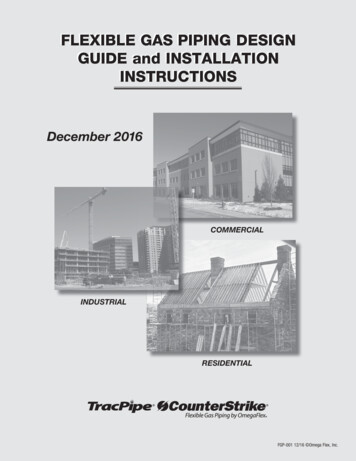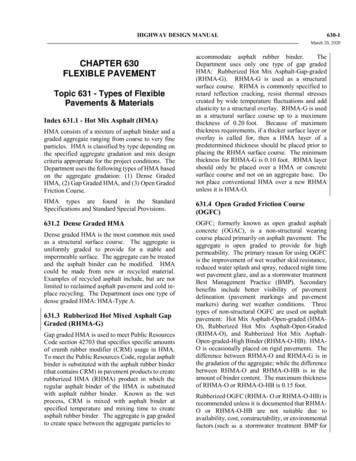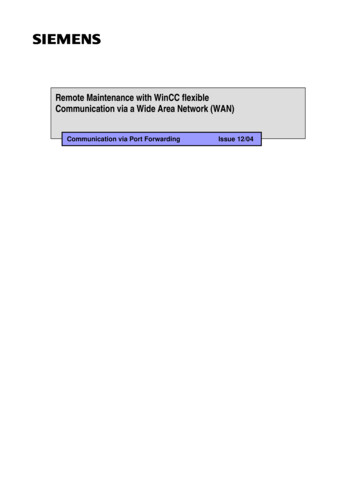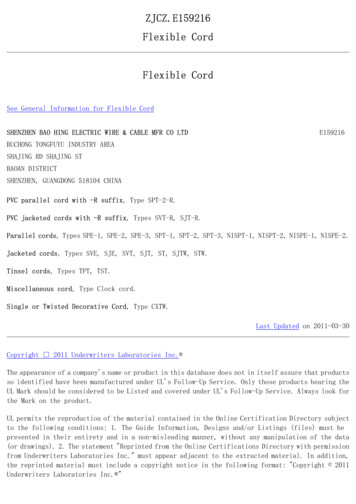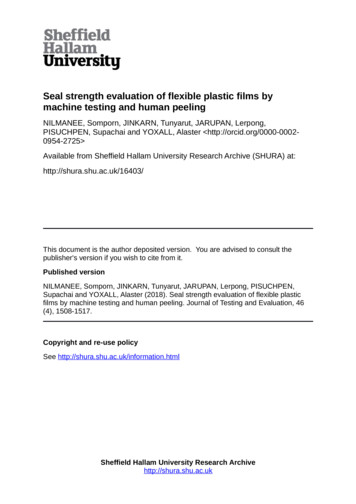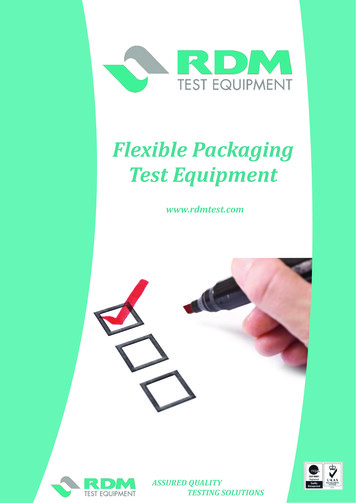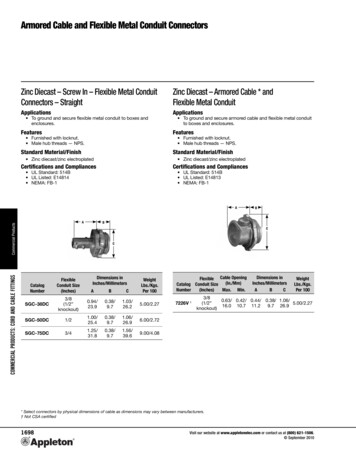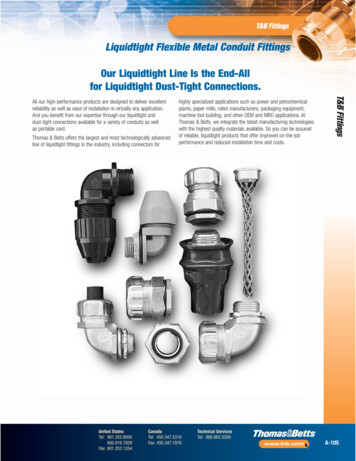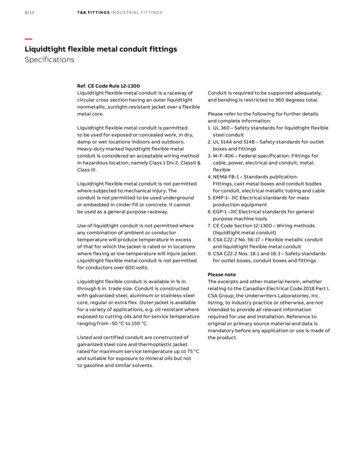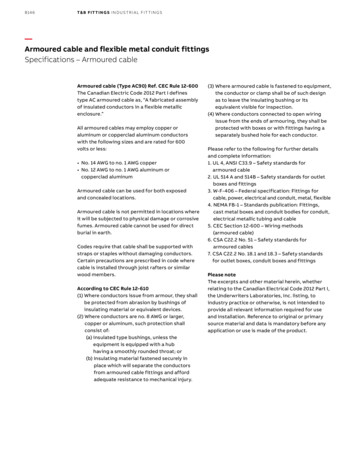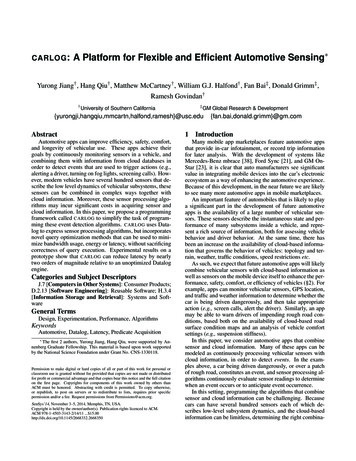
Transcription
CARLOG :A Platform for Flexible and Efficient Automotive Sensing Yurong Jiang† , Hang Qiu† , Matthew McCartney† , William G.J. Halfond† , Fan Bai‡ , Donald Grimm‡ ,Ramesh Govindan†† University‡ GMof Southern }@usc.eduGlobal Research & utomotive apps can improve efficiency, safety, comfort,and longevity of vehicular use. These apps achieve theirgoals by continuously monitoring sensors in a vehicle, andcombining them with information from cloud databases inorder to detect events that are used to trigger actions (e.g.,alerting a driver, turning on fog lights, screening calls). However, modern vehicles have several hundred sensors that describe the low level dynamics of vehicular subsystems, thesesensors can be combined in complex ways together withcloud information. Moreover, these sensor processing algorithms may incur significant costs in acquiring sensor andcloud information. In this paper, we propose a programmingframework called CARLOG to simplify the task of programming these event detection algorithms. CARLOG uses Datalog to express sensor processing algorithms, but incorporatesnovel query optimization methods that can be used to minimize bandwidth usage, energy or latency, without sacrificingcorrectness of query execution. Experimental results on aprototype show that CARLOG can reduce latency by nearlytwo orders of magnitude relative to an unoptimized Datalogengine.Many mobile app marketplaces feature automotive appsthat provide in-car infotainment, or record trip informationfor later analysis. With the development of systems likeMercedes-Benz mbrace [38], Ford Sync [21], and GM OnStar [23], it is clear that auto manufacturers see significantvalue in integrating mobile devices into the car’s electronicecosystem as a way of enhancing the automotive experience.Because of this development, in the near future we are likelyto see many more automotive apps in mobile marketplaces.An important feature of automobiles that is likely to playa significant part in the development of future automotiveapps is the availability of a large number of vehicular sensors. These sensors describe the instantaneous state and performance of many subsystems inside a vehicle, and represent a rich source of information, both for assessing vehiclebehavior and driver behavior. At the same time, there hasbeen an increase on the availability of cloud-based information that governs the behavior of vehicles: topology and terrain, weather, traffic conditions, speed restrictions etc.As such, we expect that future automotive apps will likelycombine vehicular sensors with cloud-based information aswell as sensors on the mobile device itself to enhance the performance, safety, comfort, or efficiency of vehicles (§2). Forexample, apps can monitor vehicular sensors, GPS location,and traffic and weather information to determine whether thecar is being driven dangerously, and then take appropriateaction (e.g., screen calls, alert the driver). Similarly, an appmay be able to warn drivers of impending rough road conditions, based both on the availability of cloud-based roadsurface condition maps and an analysis of vehicle comfortsettings (e.g., suspension stiffness).In this paper, we consider automotive apps that combinesensor and cloud information. Many of these apps can bemodeled as continuously processing vehicular sensors withcloud information, in order to detect events. In the examples above, a car being driven dangerously, or over a patchof rough road, constitutes an event, and sensor processing algorithms continuously evaluate sensor readings to determinewhen an event occurs or to anticipate event occurrence.In this setting, programming the algorithms that combinesensor and cloud information can be challenging. Becausecars can have several hundred sensors each of which describes low-level subsystem dynamics, and the cloud-basedinformation can be limitless, determining the right combina-Categories and Subject DescriptorsJ.7 [Computers in Other Systems]: Consumer Products;D.2.13 [Software Engineering]: Reusable Software; H.3.4[Information Storage and Retrieval]: Systems and SoftwareGeneral TermsDesign, Experimentation, Performance, AlgorithmsKeywordsAutomotive, Datalog, Latency, Predicate Acquisition The first 2 authors, Yurong Jiang, Hang Qiu, were supported by Annenberg Graduate Fellowship. This material is based upon work supportedby the National Science Foundation under Grant No. CNS-1330118.Permission to make digital or hard copies of all or part of this work for personal orclassroom use is granted without fee provided that copies are not made or distributedfor profit or commercial advantage and that copies bear this notice and the full citationon the first page. Copyrights for components of this work owned by others thanACM must be honored. Abstracting with credit is permitted. To copy otherwise,or republish, to post on servers or to redistribute to lists, requires prior specificpermission and/or a fee. Request permissions from Permissions@acm.org.SenSys’14, November 3–5, 2014, Memphis, TN, USA.Copyright is held by the owner/author(s). Publication rights licenced to ACM.ACM 978-1-4503-3143-2/14/11 . oduction
tions of sensors and cloud information to detect events canbe challenging. For instance, whether someone is drivingdangerously can depend not just on vehicle speed, but onroad curvature, the speed limit, the road surface conditions,traffic, visibility etc.As such, programmers will likely need to build their eventdetectors in a layered fashion, first by building lower-levelsensing abstractions, and then combining these abstractionsto develop more sophisticated event detectors. In the example above, a programmer can layer the dangerous driving detector by first building an abstraction for whether the driveris speeding (using car speed sensors and cloud-speed limitinformation), then an abstraction for whether this speed islikely to cause the driver to lose control (by analyzing thecar’s turn radius vis-a-vis the curvature of the road), andcombine these two abstractions to design the final detector.Beyond comprehensibility and ease of programming, thislayered approach has the benefit of re-use: sensor abstractions can be re-used in multiple situations. For example, theabstraction for analyzing whether driving speed is likely tocause a driver to lose control can be used in an app that tellsdrivers what speed to take an impending curve on the road.Finally, many of these event detectors may need to be tailored to individual users, since different users have differenttolerances for safety, comfort, and performance.To address this challenge, we observe that a declarativelogic-based language like Datalog [48] has many of the desirable properties discussed above. Datalog is based on thepredicate calculus of first-order logic, and supports negationof rules. In our use of Datalog (§3), sensors and cloud information are modeled as (time-varying) facts and applications define event detectors as rules which are conjunctionsof facts. An event is said to occur at some time instance ifthe predicate corresponding to a specific rule is true at thatinstant. Because facts can be materialized at different times,we need to carefully specify the temporal semantics of eventdetection. Our use of Datalog addresses the first pain pointin the following way: in Datalog, rules can be expressed interms of other rules, allowing a layered definition of rules,together with re-usability.A second challenge is having to reason about the costsof accessing sensors and cloud-based information. Accessing cloud information can incur significant latency (severalseconds in our experiments, §4), and designing efficient sensor algorithms that minimize these costs for every automotive app can be difficult, if not impossible. It is possiblein Datalog for programmers to write rules carefully to improve the efficiency of rule execution. Datalog engines perform bottom up evaluation, so a programmer can re-arrangepredicates so that sensor predicates are evaluated first. However, Datalog engines also perform optimizations to minimize redundancy, but because these engines are unaware ofthe costs of acquiring predicates, an engine may foil theseprogrammer-directed optimizations. More generally, expecting mobile app developers to reason about this cost can increase programming burden significantly.To address this challenge, we have developed automaticoptimization methods for rule evaluation that attempt to minimize latency (§4). These methods are transparent to the pro-grammer. In particular, our optimization algorithm re-ordersfact assessment (determining facts from sensors or the cloud)to minimize the expected latency of rule evaluation. To dothis, it leverages short-circuit evaluation of Boolean predicates. The expected cost is derived from a priori probabilities of predicates being true, where these probabilities areobtained from training data. During the process of predicateevaluation and short-circuiting, the optimizer also reducesworst-case latency by evaluating cloud predicates in parallel when the parallel evaluation latency is cheaper than theexpected residual cost of evaluating the un-processed predicates. More important, its optimization of expected cost iscritical: because queries are continuously evaluated, incurring worst-case latency on every evaluation can cause Datalog to miss events.We have embodied these ideas in a programming framework called CARLOG. In CARLOG, multiple mobile apps caninstantiate Datalog rules, reuse rule definitions, and can concurrently query the rule base for events. CARLOG includesseveral kinds of optimizations including provably-optimalfact assessment for a single query, and jointly optimized factassessment for concurrent queries. Experiments on a prototype of CARLOG, and trace-driven evaluations on vehicledata collected over 2,000 miles of driving, shows that it istwo orders of magnitude more efficient than Datalog’s naïvefact assessment strategy, detects 3 4 more events than thenaïve strategy, and consistently outperforms other alternatives, sometimes by 3 (§5). These evaluations also demonstrate the efficacy of multi-query optimization: without this,latency is 50% higher on average and half the number ofevents are detected.CARLOG is inspired by research in declarative programming, query optimization, and energy-efficient sensor andcontext recognition. It differs from prior work in its focus onlatency as the metric to optimize (most prior work on mobiledevices have focused on energy) and in its use of multi-queryoptimization (§6).2Background and MotivationAutomotive Sensing. Modern cars contain one or more internal controller area network (CAN) buses interconnectingthe electronic control units (ECUs) that regulate internal subsystems [30]. All cars built in the US after 2008 are required to implement the CAN standard. Cars can have upto 70 ECUs, and these communicate using the ControllerArea Network (CAN) protocols. ECUs transmit and receivemessages that contain one or more sensor readings that contain information about a sensed condition or a system statusindication, or specify a control operation on another ECU.ECUs generate CAN messages either periodically, or periodically when a condition is sensed, or in response to sensorvalue changes or threshold crossings. The frequency of periodic sensing depends upon the specific data requirementsfor a vehicle system. Certain types of information may bereported by a module at up to 100Hz, whereas other typesof information may be communicated only at 1-2Hz. Examples of sensor readings available over the CAN bus include:vehicle speed, throttle position, transmission lever position,automatic gear, cruise control status, radiator fan speed, fuel
capacity, and transmission oil temperature.While the CAN is used for internal communication, it ispossible to export CAN sensor values to an external computer. All vehicles are required to have an On-Board Diagnostic (OBD-II) [1] port, and CAN messages can be accessed using an OBD-II port adapter. In this paper, we usea Bluetooth-capable OBD-II adapter that we have developedin order to access CAN sensor information from late-modelGM vehicles. (Commercial OBD-II adapters can only accessa subset of the CAN sensors available to us). This capability permits Bluetooth-enabled mobile devices (smartphones,tablets) to have instantaneous access to internal car sensorinformation. Some modern cars can have several thousandsensors on-board.Automotive Apps. The availability of a large number of sensors provides rich information about the behavior of internalsubsystems. This can be used to develop mobile apps for improving the performance, safety, efficiency, reliability, andcomfort of vehicles [20]. Many of these goals can be affected by other factors: the lifetime of vehicle componentscan be affected by severe climate, fuel efficiency by trafficconditions and by terrain, safety by road surface and weather,and so forth. Increasingly, information about these factors isavailable in cloud databases, and because mobile devices areInternet-enabled, it is possible to conceive of cloud-enabledmobile apps that combine cloud information with car sensorsin order to achieve the goals discussed above.In this paper, we focus on such mobile apps, specificallyon event-driven apps that combine sensor and cloud information in near real-time (safety-critical hard real-time taskssuch as collision avoidance or traction control are beyond thescope of this paper; specialized hardware is needed for thesetasks). This class of apps is distinct from automotive appsthat record car sensor information for analytics (e.g., for assessing driver behavior, or long-term automotive health). Inother words, detected events are not just meant to be collected and reviewed later by drivers, but used by near realtime apps that either act to alert the driver or perform an action on their behalf (e.g., an app might wish to block callsor texts based on whether a driver is executing a maneuverthat requires their attention) or used by crowd-sourcing appsto notify other drivers (e.g., an app might upload a detectedevent indicating an icy road to a cloud service so that othercars can receive early warning of this hazard). Therefore, inour setting, detection latency and detection accuracy are important design requirements. These two criteria are related:as we show in §5, poorly designed detectors which incur highlatency can also incur missed detections.Examples. Consider an app that would like to detect when adriver is executing a dangerous sharp turn. This informationcan be made available to parents or driving instructors, orused for self-reflection. Detecting a sharp turn can be trickybecause one has to rule out legitimate sharp turns at intersections, or those that follow the curvature of the road. Accordingly, an algorithm that detects a sharp turn has to accessan online map database to determine whether the vehicle isat an intersection, or to determine the curvature of the road.In addition, this algorithm needs access to the sensor thatprovides the turn angle of the steering wheel, and a sensorthat determines the yaw rate (or angular velocity about thevertical axis). Continuously fusing this information can helpdetermine when a driver is making a sharp turn. Finally, wenote that any such algorithm will include thresholds that determine safe or unsafe sharp turns; these thresholds are oftendetermined by driver preferences and risk-tolerance.Consider a second example, an application that would liketo block incoming phone calls or text messages when a driveris driving dangerously. Call blocking can be triggered by acollection of different sets of conditions: a combination ofbad weather, and a car speed above the posted speed limitor bad weather and a sharp turn. This illustrates an eventdriven app, where events can be defined by multiple distinctalgorithms. More important, it also illustrates layered definitions of events, where the call block event is defined in termsof the sharp turn event discussed above. In §5, we describeseveral other event-driven apps.Datalog. Datalog [48] is a natural choice for describing sensor fusion for event-driven apps. It is a highly-mature logicprogramming language whose semantics are derived fromthe predicate calculus of first-order logic. Datalog permitsthe specification of conjunctive rules, and supports negationand recursion, and is often used in information extraction,integration, and cloud computing [27].Facts and Rules. Operationally, a Datalog system consists oftwo databases: an extensional database (EDB) which contains ground facts, and an intensional database (IDB) whichconsists of rules. Facts describe knowledge about the external world; in our setting, sensor readings and cloud information provide facts instantiated in the EDB. Rules aredeclarative descriptions of the steps by which one can inferhigher-order information from the facts. Each rule has twoparts, a head and a body. The head of a rule is an atom, andthe body of a rule is a conjunction of several atoms. Eachatom consists of a predicate, which has one or more variables or constants as arguments. Any predicate which is thehead of a rule is called an IDB-predicate, and one that occursonly in the body of rules is called an EDB-predicate.For example, the code snippet shown below describes arule that defines a dangerous driving event. The head of therule contains the predicate DangerousDriving, with fourvariables, and the body is a conjunction of several predicates,some of which are automotive sensors (like the Yaw Rateand the Steer Angle) and others access cloud informationsuch as SpeedLimit. Dangerous driving is said to occurwhenever the yaw rate exceeds 25 rad/s, the steering angleexceeds 15 , and the vehicle speed exceeds the speed limitby a factor of more than 1.2. Thus, for example, when theYaw Rate sensor has a value 30 rad/s (when this happens, afact Yaw Rate(30) is instantiated in the EDB), and the steering angle is 60 , and car is being driven at 45mph in a 30mphzone, a new fact DangerousDriving(30,60,45,30) is instantiated into the EDB and signals the occurrence of a dangerous driving event.DangerousDriving(x,y,z,w):Yaw rate(x), x 15, Steer Angle(y), y 45,Vehicle Speed(z), SpeedLimit(w),MULTIPLY(w, 1.2 , a), a z.
3CARLOG DesignIn this section, we describe the design of a programmingsystem called CARLOG that simplifies the development ofevent-driven automotive apps. CARLOG models car sensorsand cloud based information as Datalog predicates, and appscan query CARLOG to identify events.Figure 1 shows the internal structure of CARLOG. TheSensor Acquisition and Cloud Acquisition modules accessinformation from the car’s sensors and the cloud, respectively, and provide these to the Interface module in the formof Datalog facts. The Interface module takes (1) app-definedqueries and (2) facts from the sensors, and passes these toa modified Datalog query processing engine that performsquery evaluation.CARLOG introduces two additional and novel components, the Query Optimizer and the Query Plan Evaluator.The Query Optimizer statically analyzes a query’s associated rules and determines an evaluation plan for rule execution. Unlike traditional Datalog optimization, the Query Optimizer attempts to minimize query evaluation latency basedon the latency of acquiring cloud information, instead of thenumber of rules to be evaluated. The output of the QueryOptimizer is a query plan executed by the Query Plan Evaluator. In the remainder of this section, we describe CARLOGin more detail, and in §4 we discuss the Query Optimizer andQuery Plan Evaluator.How Apps use CARLOG. Event-driven apps instantiate Datalog rules in CARLOG. Typically, these rules define eventsfor wh
Many mobile app marketplaces feature automotive apps that provide in-car infotainment, or record trip information for later analysis. With the development of systems like Mercedes-Benz mbrace [38], Ford Sync [21], and GM On-Star [23], it is clear that auto manufacturers see significant value in integ
